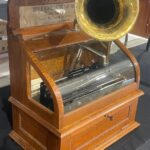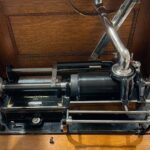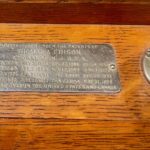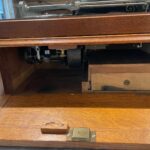Edison Coin-Slot Phonograph – Type H
Serial No. H27619 – Chain Repeater Version. Edison Phonograph Works, Orange, New Jersey
ca. 1898–1899 | First factory-produced coin-operated phonograph by Edison
Historical Background
The Edison Coin-Slot Phonograph Type H was the first coin-operated phonograph officially built by Edison himself, designed for bars, train stations, saloons, and amusement venues of the 1890s.
The Type H marks the beginning of commercialized recorded sound:
A customer inserted a coin — and only then was able to wind the machine by hand and listen to a musical or spoken-word cylinder.
Production ran for only a very short period (1898–1899), which is why only about a dozen examples survive today — and only a handful remain in excellent original condition.
Chain Repeater – the Rarest Version
The Type H exists in two versions:
-
String Repeater – simple cord mechanism
-
Chain Repeater – more advanced chain-driven system
H27619 in the Edisonium is equipped with the extremely rare Chain Repeater, which:
-
enables more reliable automatic reset
-
provides steadier start/stop regulation
-
proved far superior for commercial use
Only very few Type H machines were fitted with this high-quality mechanism.
Technical Features
-
Clockwork-driven mechanism, wound by the customer after inserting a coin
-
Locking system preventing operation without payment
-
Chain Repeater for automatic resetting of the machine
-
Solid, richly decorated oak cabinet
-
External horn, chosen according to venue size
Original price in 1898: 50 US dollars
Contemporary advertisements praised the Type H as “solid and substantial” — and as a major improvement over the expensive battery-powered machines of the era.
Rarity and Condition
Serial number H27619 ranks among the finest surviving Edison H Coin-Ops:
-
virtually no signs of wear
-
original mechanism, unrestored
-
exceptional overall condition (“as if unused”)
For coin-operated phonographs that once stood in public venues, such preservation is extraordinarily rare.
Significance
The Edison Type H stands at a defining moment in media history:
-
first coin-operated machine produced directly by Edison
-
early precursor to all later music machines and jukeboxes
-
beginning of “pay-per-play” culture in recorded sound
-
milestone between laboratory experimentation and public entertainment
It demonstrates how recorded sound became a product that anyone could hear — for just a small coin.
Conclusion
The Edison Coin-Slot Phonograph Type H, No. H27619, is an exceptionally rare and globally significant artifact of early sound entertainment.
It marks the transition from experimental apparatus to commercially viable coin-operated amusement machines.







